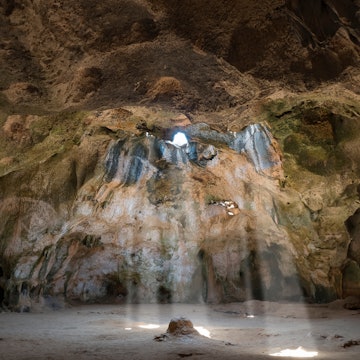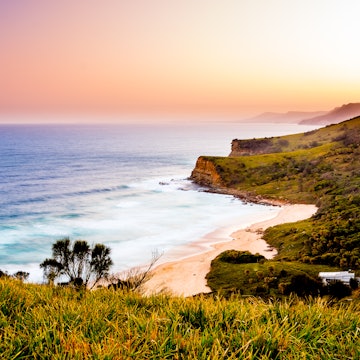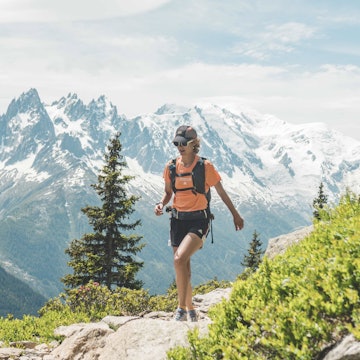

Arrange your trip into the Tunisian Sahara from the town of Douz. camor8icosa / Shutterstock
Long a popular winter sun destination for Europeans, Tunisia’s resorts and beaches often come with locals leading brightly saddled camels for tourists to ride next to the sea. However, it's easy to plan an even bigger adventure in far more epic surroundings. Head towards Tunisia's other great expanse of sand in the country’s deep south, which fringes the Grand Erg Oriental, an endless expanse of wind-sculpted Saharan dunes.
The Sahara, the word itself often synonymous with the whole concept of a desert, is a landscape of the imagination and one of the great frontiers of adventure travel. With Tunisia's return to the tourism scene, as a good budget alternative to Morocco, now is the perfect time to saddle up.
Douz: the gateway to the Sahara
You could start your visit to the Sahara from almost anywhere in southern Tunisia, but any trip worth your time will funnel through the gateway town of Douz, a modest, low-slung place that only really starts to come to life when the sun begins to dip. On the fringes of Douz is a large palmeraie (palm grove), with acres of green-grey palms providing shady gardens for crops, as well as mountains of dates to give sustenance to desert travellers. Beyond the palms, the desert beckons.
To get to the desert, any of Douz's Saharan tour operators can provide you with options, from an afternoon in the dunes to multi-day camping adventures according to your time and inclination. The biggest decision to make at the start is your mode of transport. If you want to range far and fast, you can get a 4WD with an expert guide who knows all the trails and can mount sand dunes that would leave an amateur struggling with a spade to dig out their vehicle. For short dune raids, quad bikes are also an option. But for both the adventurous and incurable romantic alike, there is no way to get closer to the desert than with a camel.

Camel tours in the Tunisian Sahara
If it's just a taste of the desert that you're after, many locals in Douz will offer you a camel ride on the spot, but you won't get far into the dunes, the best of which start some way from the town. For longer trips that involve camping, allow at least a day to make arrangements with a licensed tour operator – you can contact local agencies like Horizons Deserts Voyages, Sahha Sahara and Nefzaoua Voyages in advance of your trip to confirm arrangements before you arrive in Douz. Double-check what meals and camping equipment (including bedding) is included in the price and just how far your trip will go into the desert: you don’t want to travel all this way to only to have your camel walk a mile past the town limits.
An overnight tour is the most popular option. After some instruction on the best way to mount your camel and stay in the saddle when it rises to its feet (an unexpectedly wobbly experience), you set out after the heat of the day burns off to ride to a campsite. Around four hours of trekking is a typical first day, which is more than enough to pick up the swaying rhythm of your mount and also to anticipate which parts of your body might be sore the next day.
The reward is arriving deep enough into the desert to enjoy the sunset far from civilisation. Camping involves a traditional black woollen Berber tent, but it's even more fun to sleep outside under the dizzying night sky – a million-star hotel, as your guide will gleefully point out.
Dinner is eaten around a campfire. Quite commonly, it will be a simple stew in a pot that can be wrapped in foil and buried to cook in the fire, along with unleavened bread baked in ashes. While dinner cooks, teapots boil on top of the fire, stuffed with gunpowder tea and mint, and a fistful of sugar that would appear shocking if you hadn't just spent half a day burning calories just holding on to your stead.
The next morning, you rise with the sun and strike camp after a simple breakfast and more sweet tea, and head deeper into the Sahara, or if you're on a shorter trip, back towards Douz.
Sanctuary oasis of Ksar Ghilane
A popular destination for shorter desert trips in the Tunisian desert is the oasis of Ksar Ghilane. You could make a serious trek there by camel from Douz in around a week, but those more pressed for time can reach it by sealed road from Douz in a couple of hours (or have your guide from Douz dune-bash it here in a 4WD).
A beautiful palm-green dot holding back enormous waves of sand, Ksar Ghilane has long attracted outside attention, from Roman legionaries on the outposts of empire to military manoeuvres during World War II. Today it's rather more peaceful, with campsites of traditional Berber tents pitched under palm trees huddled around the fresh springs at its centre. Camels, of course, are available to take you into the dunes, as well as a stable of fine Arab horses and rather noisier quad bikes.

Timing your trip
It's vital to pick the right time of year to visit the Tunisian Sahara. The optimal months are between October and May when the daytime temperatures are at their best. The later you travel during this period, the hotter things will get – you are visiting a desert after all – but the lightest showers of spring rain can generate pretty carpets of short-blooming flowers.
In December and January, nights can be cold and can even approach freezing, so be sure to pack warm clothes and make sure your tour operator has plenty of blankets.
From June to September, the scorching summer sun makes Saharan travel unbearable. Many local tour companies in Douz usually shut up shop during this period, and camels are turned loose to forage for themselves until the cooler weather starts to return.
Packing for the desert
The Saharan sun can be unrelenting no matter the calendar, so do as the Berbers do and cover up when you're out on your adventure. A brimmed hat and high-factor sunscreen are both essential, along with a loose scarf to cover yourself against dusty winds. Long sleeves and trousers are ideal; hours in the saddle can easily chafe. Bring something warm for the end of the day, as desert nights can be surprisingly cold. Your guides should bring plenty of water – always double check this and carry your own bottle in your daypack. Dried fruits and nuts for energy when you're the saddle are a good idea, and the markets in Douz can keep you supplied, along with plenty of locally produced dates.
Check out adventure tours for every traveller from our trusted partners.













